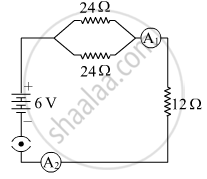Advertisements
Advertisements
Question
Answer the following question.
An electric lamp of resistance 20 Ω and a conductor of resistance 4 0 are connected to a 6 V battery as shown in the circuit. Calculate: 
(a) the total resistance of the circuit,
(b) the current through the circuit,
(c) the potential difference across the (i) electric lamp and (ii) conductor, and
(d) power of the lamp.
Solution
Resistance of electric lamp = 20 Ω
Resistance of conductor = 4 Ω
Voltage battery = 6 V
(a) Total resistance of circuit = 20 Ω + 4 Ω = 24
(b) Resistance of conductor= 4 Ω
Voltage battery = 6 V
Apply Ohms law
6 V =` "I"` × 24 Ω
`"I" = (6"V")/(24Ω) = 0.25"A"`
Hence, current in the circuit is 0.25A
(c)
(i) Potential difference across the lamp
Vlamp = IR
Vlamp = 0.25 A × 20 Ω = 5 V
∴ Vlamp = 5 V
(ii) Potential difference across the conductor
`"V"_"conductor" = "IR"`
`"V"_"conductor" = 0.25 "A"xx4 Ω = 1 "V"`
`"V"_"conductor" = 1"V"`
(d) Power of lamp
`"I"^(2)"R" = (0.25)^2 xx 20 = 1.25 "W"`
APPEARS IN
RELATED QUESTIONS
Why are metals good conductors of electricity whereas glass is a bad conductor of electricity? Give reason?
<p> Define the unit of electric current (or Define ampere).
Which is the better way to connect lights and other electrical appliances in domestic wiring: series circuits or parallel circuits? why?
Two resistors of 2.0 Ω and 3.0 Ω are connected (a) in series (b) in parallel, with a battery of 6.0 V and negligible internal resistance. For each case draw a circuit diagram and calculate the current through the battery.
A cell supplies a current of 1.2 A through two 2 Ω resistors connected in parallel. When the resistors are connected in series, it supplies a current of 0.4 A. Calculate: (i) the internal resistance and (ii) e.m.f. of the cell.
Electrical power P is given by the expression P = (Q × V) ÷ time
(a) What do the symbols Q and V represent?
(b) Express the power P in terms of current and resistance explaining the meanings of symbols used there in.
Study the following circuit and find out:
(i) Current in 12 Ω resistor.
(ii) The difference in the readings of A1 and A2, if any.

The power of an electric device is a product of ______ and ______.
Unit of electric power may also be expressed as
